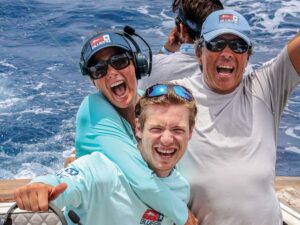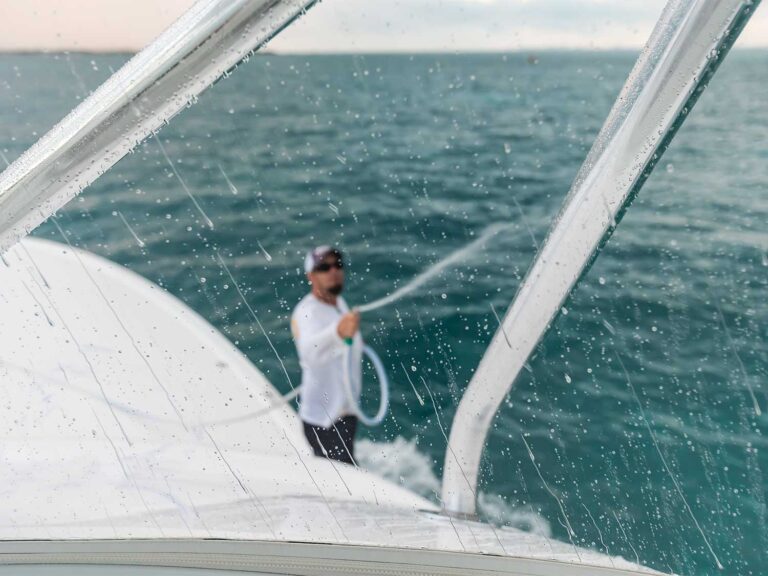
Special delivery: Sign up for the free Marlin email newsletter. Subscribe to Marlin magazine and get a year of highly collectible, keepsake editions – plus access to the digital edition and archives.
It was another beautiful day when Sensei, a 42-foot Rodman and flagship of the Azores Fishing Charters fleet, left her slip in Horta, a city on the island of Faial in the Azores. As we left the marina and entered the channel between Horta and Pico, the sun had risen over the cap of the Pico stratovolcano and a stunning vista stretched out before us. Andrea Beuter and I were beyond thrilled to fish together where we had met—she had traveled from Munich, while I had made the trip from Gulf Shores, Alabama, to meet in one of the most fertile blue marlin and tuna fisheries in the world.
We headed north to fish in the lee of the island, avoiding the 10-to-12-foot seas on the Azores Bank. Aboard was Capt. Diogo Paiva at the helm and mates Jaoa Palhinha and Bernardo Pacheco working the deck. Another of Beuter’s friends, Cesar Ferreira, was along to video her catches that day, as we were chasing a world record. For the third season in a row, Beuter has been on a mission to land a women’s record blue marlin on 50-pound-test. Her angling passion first sprouted as a young child fishing in the rivers of the Bavarian Alps with her grandfather; she traveled to the Florida Keys at age 13 to learn saltwater fishing and never looked back.
For Beuter, failure begets more research and adjustments, as with most anglers intent on chasing IGFA records. We first met during a meet-and-greet party aboard Anthony Hsieh’s Bad Company when they were in the Azores. I’ve never met a more voracious and dedicated female angler in my professional career, which includes many years working for Marlin.
Since 2020, Beuter has been fishing for world records in the Azores on 30- and 50-pound-test gear, using modified Alutecnos two-speed 50W reels. After last season, she replaced the gears, changed the drags and modified the handles to suit her style of fishing, and also designed a set of custom rods. No matter the species, her German DNA compels a certain level of detail that might border on obsession. After honing her angling skills while living in Florida, she joined the International Women’s Fishing Association as well as the IGFA and The Billfish Foundation and began traveling internationally to places such as Panama, Costa Rica, Cabo San Lucas, California and Nova Scotia, pursuing bluefin tuna, marlin and sailfish, along with roosterfish and cubera snapper; these days she’s living most of the year in the Azores.
On our fateful day, October 1, 2023, we departed early, before the other charter boats. At around 11 a.m. we had a blue marlin follow the short rigger then commit to the lure. An estimated 750 pounds, the fish was released after a fight of about 45 minutes. Within an hour we had a larger blue on the left long, and after 90 minutes we were able to successfully release that one as well—800 pounds, but not enough for the women’s record on 50.

During that release, the swivel opened and hit our mate Palhinha in the forearm, ripping open a six-inch gash. As Beuter provided first aid, we sped back to the dock, where he was taken to the local hospital. The wound was stitched up and antibiotics given; when they returned to the boat, we had a quick change of duties, with Palhinha taking over driving at hookup and Paiva switching to the mate’s job. Since we’d lost several hours of the day, we decided to fish late into the afternoon. At 4:40 p.m., we had a knockdown and Beuter began the fight, never seeing the fish or a jump, just the steady, strong pull that signaled one thing: tuna.
The fight was at times slow and methodical. At around 6 p.m. the leader appeared for Paiva and the crew struggled to boat what turned out to be a truly massive bigeye—we knew this one had potential for a record, as the existing mark for women’s 50-pound-test was 244 pounds, 11 ounces, and had been caught in 1996 in Madeira.
Once again we rushed back to the dock, this time hoping to locate a certified scale and a crane to weigh the fish. Beuter called Delcio Silva, the port manager at Horta’s commercial marina, and he arranged to have the crane ready when we arrived. Our dock mate and friend Capt. Kyle Weaver on Billable Hours had a scale that was currently certified, so we moved Sensei next door to the commercial harbor. Paul Scopinich of Scopinich Boat Works and Scopinich Fighting Chairs had heard the chatter on the docks and showed up to help us get the certified weight, specific measurements, photographic evidence and everything else needed to submit the catch as a potential world record.
When the fish was hoisted on the crane and the scale attached, we all held our collective breath until the scale settled on 292 pounds, 2 ounces, beating the current record by 9.9 pounds. There were about 20 people around the scale at the time, and we all started screaming, embracing and even shedding a few tears.
We called a friend who managed a great sushi bar in Horta and told him to get to the marina to pick up a tuna we had caught. We’d had dinner there the night before and had promised him a tuna for the restaurant. He brought his hatchback to the marina, and we were able to lay large trash bags in the cargo area to protect it from the huge fish. It took a crane and four people to load the tuna into his car, with about a half-inch to spare when the hatch was closed, and another six people at the sushi bar to deliver the fish to the kitchen. The next day was my birthday, and our group, along with a few friends, was treated to a fantastic feast of tuna, wine, sake and more. It was certainly a birthday celebration I’ll never forget.
Read Next: How to Prepare for Long-Range Fishing Trips for Marlin and Tuna
As any IGFA record holder will tell you, they do not come without a total commitment of time and resources. Although Beuter’s first one took her only about four years, she has the indomitable spirit of never giving up and still intends to chase the women’s 30-pound records for tuna and 50-pound-test blue marlin.
Just before going to press, Beuter’s fish was approved as a new world record, and she was also appointed as the IGFA representative in the Azores. She has planned more activities for the islands, including children’s fishing and education programs as well as tournaments.







